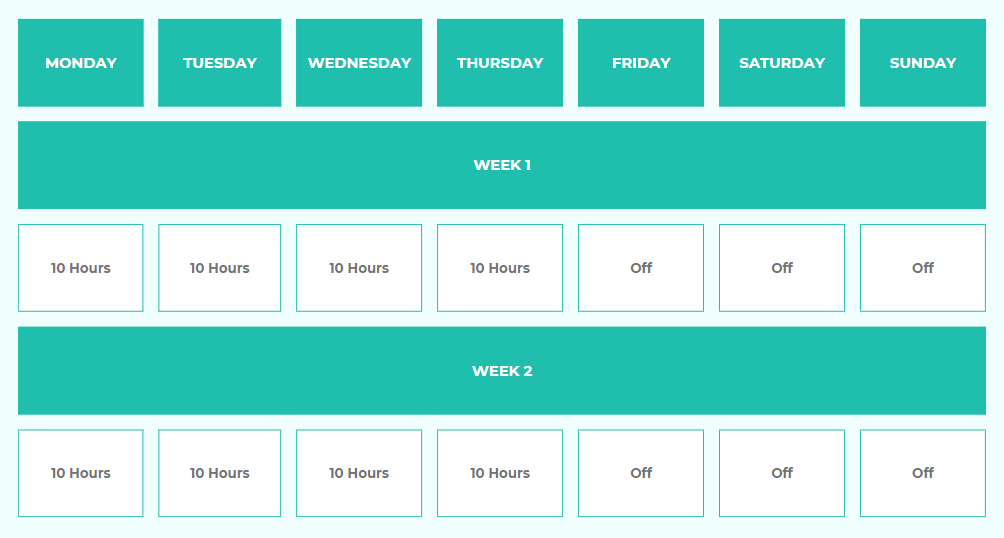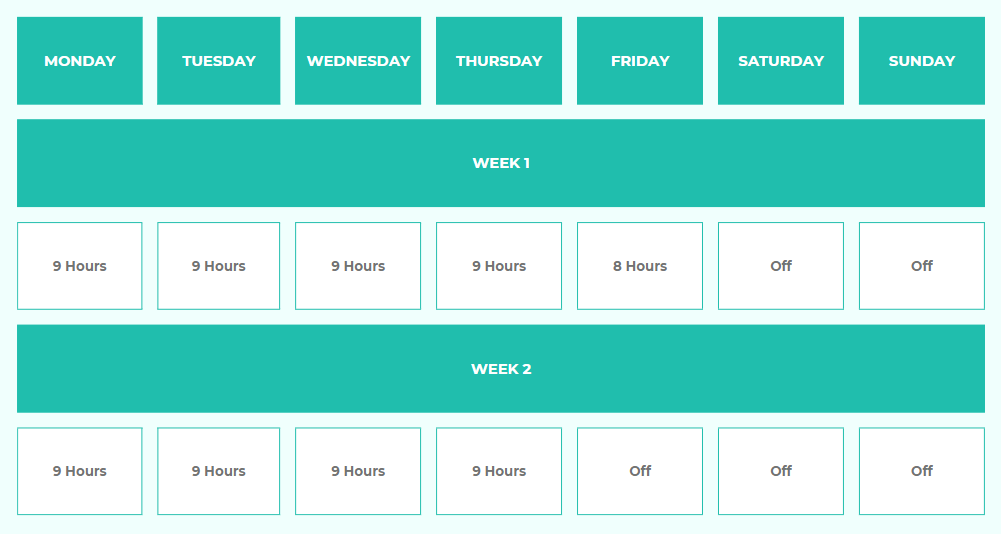15 Effective Work Schedule Types, Examples, And Templates!

It was always a challenge for me to find the right work schedule. I tried out many, hoping to improve productivity and overall efficiency.
After much trial and error, I’ve discovered the key is just to choose a perfect work schedule based on your specific needs.
But you know what’s the real challenge? Countless options are available!
However, today I'll help you with this challenge no matter whether you’re an HR manager, a business owner, or a team leader.
Here, I’ll share,
- 15 different work schedules with examples
- Tips and practices to choose the best-fit work schedule
- Insights from my own experience
Let’s get into the details.
What is the Work Schedule?
A work schedule is a plan of time and days of the week your employee will work. The work schedule includes information like working hours, breaks, and lunch times.
It also highlights when the employees will work in the organization and when they will rest. Work schedule ensures your business remains perfectly staffed during working hours.
Moreover, it helps to avoid overworking one individual.
Among the work schedule types, the most common ones include:
- Standard full-time schedule
- Part-time schedule
- Flexible work schedule
- Shift work schedule or
- Compressed work schedule
However, I’ll comprehensively describe almost all types of work schedules that are widely used across industries.
15 Types of Work Schedules for Maximum Productivity
Every work schedule has its own fair share of pros and cons. Here, I’ll share 15 different types of work schedules that I came to know.
1. Standard Schedule
A standard work schedule is commonly known as a 5-day work week schedule.
In this schedule, your employees work during the standard business hours.
Timeframe: Monday to Friday from 9 a.m. to 5 p.m.
You may find a standard schedule especially beneficial for your new employees.
Why? Most of them are likely to be used to it. That’s why they won’t need time to adjust to the work hours.
It’s the simplest structure I can implement as an employer. I can easily schedule everyone’s work in that standard timeframe.
But the standard schedule has its fair share of opposition.
Some of my employees say this schedule is too monotonous. Moreover, they say it leads to a lack of inspiration.
Similar Read:
↘️Complete Process of Designing Standard Schedule
2. Fixed Schedule
The fixed work schedule is almost similar to the standard work schedule.
Set hours and set days. But you can have alternative work time. For instance,
Timeframe: Tuesday to Saturday from 9 a.m. to 5 p.m.
Here, times and days can differ.
A fixed schedule is also advantageous in many ways.
For example, as an employer, I can do long-term planning with this schedule. It makes it easier for me to calculate labor costs as well.
Moreover, creating this schedule is much simpler. I don’t have to change my regular template when I make new schedules.
3. Full-Time Work Schedule
The full-time employees have to work 37 to 40 hours per week in this schedule. They may work four 10-hour days or five 8-hour days. It can also be six 6.5-hour days.
The workday doesn’t matter, actually. What matters is the total amount of full-time hours!
Try Apploye to Track Employee Working Hours More Effectively!
As I’ve experienced, a full-time work schedule brings stability from both sides. Employers and employees.
Full-time employees are somewhat worry-free about monthly earnings as they get a fixed salary.
However, this schedule is sometimes inconvenient for employees who prioritize flexibility.
4. Part-Time Work Schedule
Here, the employers work fewer hours than full time.
They may work only two or three days per week. It does not necessarily have to be an 8-hour workday.
Timeframe: It varies depending on the business needs.
In recent years, part-time work schedules are becoming more common.
As of July 31, 2024, about 27.73 million people are working on a part-time schedule.
You know this type of schedule fits perfectly for businesses like coffee shops or restaurants. But I think it’s an extra headache for the businesses that require a consistent team.
So, you've got to choose this schedule based on your business type.
5. Shift Work Schedule
When your company operates more than 10 hours per day, you can consider a shift work schedule for continuous coverage. Here, employee monitoring software can be a real help for tracking productivity.
Here’s how the shift work schedule works.
First Shift:
For the first shift, your employees will work during the day. They will have the evening off.
Shift hours will vary depending on your company.
Timeframe: It can be a 9 am to 5 pm shift or a 7 am to 3 pm shift.
It’s all your choice!
Second Shift:
Your employees will start a second shift when the first shift ends.
The second-shift working employees will get the morning and night off.
Timeframe: For example, it can be 3 pm to 11 pm or 1 pm to 9 pm.
Third Shift:
The third shift is generally known as the night shift.
Your employees will start third shifts at midnight and end in the morning.
Timeframe: Typically, it’s from 11 p.m. to 7 a.m. or 12 p.m. to 8 a.m.
Shifts by industry:
Some industries implement their working shift to meet their operational needs.
For instance, the medical sector.
Medical assistants often have to work full-time with varying shifts. They may also do overtime shifts due to the patient's needs.
Do you know how many of them work overnight shifts? It’s about 27% of healthcare practitioners.
6. Remote Work
Timeframe: No specific time.
A remote work schedule allows the employees to work other than the office. It can be at home or any other remote location.
Remote work allows working for multiple clients or companies at a time.
They don’t necessarily need to set work schedules as they get payment per project.
When you choose remote work, your employees get the freedom to work whenever they like.
It increases employee satisfaction and reduces employee turnover.
Moreover, it ensures a better work-life balance. According to a report by Owl Labs, remote work experiences 25% lower employee turnover.
However, for this type of work, the employee requires a strong relationship with the employer.
Then, it’ll be easier for them to shift to remote work from a standard or fixed schedule.
Of course, only if the option is available!
As for the employer, they will need an effective tool to track time for remote employees.
Read More:
↘️How to Convince Your Boss to Work Remotely
Ensure your remote workers are working properly
7. Flexible Schedule
A flexible schedule is less rigid than a fixed schedule.
In this hybrid work schedule, the employer and employee both work together to determine the number of work hours and days.
Honestly, I have noticed better job satisfaction and improved team spirit with this work schedule. That’s so because they get the freedom to balance work and life.
Here are a few popular flexible schedules that work really well for different employment types.
Flexitour
In this type of flexible schedule, you choose a specific start or stop time for each workday. However, it can be different from day to day.
But the schedule will stay the same every week. Your employee will work for about 8 hours a day and 5 days a week.
Gliding
Gliding work schedule offers flexibility in the start and end times each day.
Still, you have to work five 8-hour days a week.
However, you are free to choose when to begin and when to end in that timeframe.
Suppose you start your workday anytime between 7 am and 10 am. Now you can adjust your departure time depending on when you have arrived accordingly.
In this case, it will be between 3.30 pm and 6.30 pm with a 30-minute lunch break.
Variable Day
Here, the workday for your employee can be slightly longer or shorter than 8 hours.
But it must have added up to 40 hours in a week. Your employees will work 5 days here also.
You can consider the below table as an example.
Variable Week
Variable-week schedules vary week to week.
- Each day's working hours can be slightly longer or shorter than 8 hours.
- Each week can be longer or shorter than 40 hours. But when working hours of two weeks add up, it will be 80 hours for the pay period.
- Your employee will work 5 days a week.
You can organize the workweek like the below template.
Maxiflex
It is also the same as the variable week.
However, here your employee will work 9 days instead of 10 days per pay period.
But the per-pay period working hours will be 80 hours.
Further Read:
↘️Why Flexible Work Schedules Improve Team Spirit
8. Compressed Schedule
In compressed work schedules, employees work longer than the 9-to-5 workday. Instead, they can get an extra day off.
A compressed work schedule is beneficial for both the employee and the employer.
The employees get the bonus of an extra day off.
As for the employees like us, it’ll be easier to calculate the labor cost and schedule the work.
Try Apploye Now for Smart Employee Scheduling!
You can see different forms of compressed schedules depending on the needs of your business.
4/10 Shift Schedule
A 4/10 shift schedule is the most common form of a compressed work schedule.
Your employees will work for 10 hours a day and take Friday off.
An extra day off offers the employee a good work-life balance and extra burnout.

9/80 Shift Schedule
In the 9/80 shift schedule, your employees will complete 80 hours of work in just 9 days.
Like the 4/10 schedule, employees get an extra day off. But they get it every other week.
Here’s how the schedule works.
- Week 1: Employees will work for five days. First four days for 9 hours and one day for 8 hours.
- Week 2: Employees will work four days for nine hours and will take Friday off.

12-hour shifts under a 3-week cycle
Your employees will work for 12 hours for fewer work days.
For instance, the first week is 48 hours, and the second week is 36 hours.
As for the third week, it can be 48 hours.
So, on average, employees will work 44 hours on average per week under a 3-week work cycle.
9. Rotating Schedules
It is one type of shift work.
Rotating schedules is a standard for organizations that need 24 hours of continuous operation.
When you choose a rotating schedule, your schedule changes every week.
That means you’ll need an effective time-tracking app to track the employees' rotating shifts.
Dupont shift work schedule
Dupont's work schedule is the most common choice for healthcare sectors and police stations that run 24/7.
It is often referred to as a 7-day workweek schedule.
For this schedule, you will have four different teams. They will work a 12-hour shift.
The teams will rotate through over a four-week cycle.
Here is how the schedule works.
- Week 1: Four night shifts, three days off
- Week 2: Three-day shift, three-night shift, one day off
- Week 3: Four-day shift, three days off
- Week 4: Seven days off
Pitman Shift Work Schedule
It is almost similar to the Dupont work schedule.
The main difference is that the teams rotate through over a two-week cycle instead of a four-week cycle.
Moreover, your employees do not have to work more than three consecutive days.
- Week 1: Two-day shifts, two days off, three-night shifts
- Week 2: Two days off, two-day shifts, three days off.
2-2-3 Shift Schedule
Another popular option for the 24/7 operating organization is the 2-2-3 work schedule.
Here is how four team working hours rotate.
- Two-day shift: Two 12-hour day shift
- Two days off
- Three-day shift: 3 12-hour day shifts
The employees will work either day shifts or night shifts in this work schedule.
They can’t switch between them. It provides consistency to their schedules.
Similar read:
↘️What is a 2-2-3 Work Schedule and How Does It Work?
10. On-call or irregular work schedule
As for the on-call work schedule, the employees work on the employer's demands.
Generally, they work without the set hours. However, the employees receive extra pay as they don’t have guaranteed time off.
However, if you want to implement this schedule, you have to make turns with your on-call employees.
So that one employee isn’t always working and to avoid burnout.
To be honest, this work schedule is suitable for unpredictable work scenarios.
For instance, the physician. They may have at least one on-call work day in a month for emergencies.
11. Split Work Schedule
In this split shift schedule, you work several hours a day, then take a few hours break. Then again get back to work on the same day to complete the shift.
For instance, suppose you’ve worked 6 hours in the morning. Then you can have about an hour's break.
But again, you have to go back to work to complete the remaining two hours.
I never preferred a split work schedule. That’s because this is the most challenging work schedule that I ever experienced.
A split-shift schedule allows very little flexibility during the day. Moreover, it becomes almost impossible to do longer activities. But things can be different at your end. Feel free to try it yourself before making a final judgment.
12. Seasonal Work Schedule
Seasonal employees work only for a few months per year. I think this seasonal schedule is great for students.
Because they have the opportunity to focus on their studies during the academic year.
As far as I know, the schedule has November to December holidays and summer from June to August.
13. Overtime Schedule
It means working more hours than the standard working hours in a day. As a return, the wages for overtime work are higher than the 40-hour work schedule.
You may need overtime employees, especially for your big projects or certain times of the year. Typically you you’ll have to pay 1.5 times the regular salary for overtime work according to maximum countries’ labor laws.
14. No Set Schedule
Here, the employees have a set task and responsibilities that they have to complete. But you don’t fix the hours they have to work.
As there is no fixed schedule, they can opt to work in the morning or at night.
You may think it is almost similar to remote work.
But the difference is that your employee has to report to your office to perform their work.
Keep track of your employee at any schedule
15. Customized or Alternate Work Schedule
It is when your employee works on a different work schedule than your other employees working in the same role.
The employees may ask to allow this type of schedule when they have unusual needs.
For instance, in pregnancy or medical requirements, they may need this alternative work schedule.
Why is A Work Schedule Important?
Let’s have a quick insight into why a work schedule is important.
- Proper work schedules ensure employees remain on track and enhance productivity.
- A well-planned schedule reflects the care and respect of the organization for its employees. It increases morale and job satisfaction.
- Work schedules reduce employee turnover. That’s because employees' work is well planned and has no issues with their hours.
- It prevents employees from overworking and burnout. Moreover, it helps to balance personal and work life.
- Your company can run smoothly with a structured schedule. It leads to better operational efficiency.
Best Practices When Choosing a Work Schedule
Now that you know all the types of schedules, here is one important thing.
What will be the best practice when choosing an effective work schedule among these many types?
The steps below can really help.
1. First, determine the core hours of your company
The core hours of your company are the times when all your employees should be at work.
Identify the essential core hours when your business requires to be fully operational.
It’ll help you to plan schedules around those core hours.
2. Define scheduling rules
You should use regulations or policies to define scheduling factors.
For instance, employees with more tenure may have more flexibility than others within their schedules.
Be sure to include these rules in your employees' hiring contracts and handbook.
Thus, your employees can refer to them if they have any questions.
3. Set clear expectations when hiring
You should be upfront about the work schedule when hiring new employees.
Clearly communicate with them your expected working hours and whether there is any chance for flexibility.
This approach will help the new employees understand what you expect.
Moreover, it’ll reduce the potential conflicts later on.
4. Schedule in advance
It is best practice to provide the schedule to the employees in advance.
The employees can easily plan their times when they know their work schedules ahead.
Moreover, they can prepare for their shifts and plan for their personal matters and other responsibilities.
5. Ask for feedback
It’s important for employers to request feedback from the employees.
Their feedback will offer you useful insights about what’s working on the work schedule and what's not.
You can make tweaks in the working shifts and working hours according to their feedback.
Again, you can make the scheduling more effective.
How to Create a Work Schedule for Your Business
You can create a work schedule on your own to meet your business needs and employee preferences. Here’s what I do.
Identifying the resources
First, I assess the number of employees, their availability, and their skills. It helps me to decide which type of schedule my business needs.
Analyzing the workload of the business
Next, I analyze the workload of my business for effective schedule planning.
You should do so, especially for your service-based business, because demand varies there.
By analyzing employee tasks and customer volume, I can ensure proper staffing at peak times.
You may also like:
↘️Workload Management—How to Master It
Listing the shift needs
Now, you should list the needs of each shift.
An effective schedule requires matching the right skills with the specific role, except just timing.
Then, you can put the right employee on the right shift.
Collecting the employee preference
I think work schedules are most effective when employees get involved in creating them.
I suggest you ask your employees for their preferred hours, days off, and personal commitments.
I know it’ll not be possible to meet all the preferences. But still, I believe your sincere effort will at least boost morale.
Reviewing the past schedules
Never forget to review the past schedules.
You can find areas for improvement and make better decisions through it.
I especially look for overstaffing, understaffing, and employee feedback.
Using scheduling tools
I generally use tools to create an effective schedule. I just love how these tools make it easy for everyone to manage and modify their schedules.
Here are a few tools you can try: When I Work, APS Online, Hot Schedules, etc.
Communicate effectively
Lastly, ensure clear communication with your team once you’re done creating the schedule.
Always try to make it easily accessible for all of your employees. Plus, provide channels for questions or requests.
You’ll also agree that effective communication helps to avoid misunderstandings and conflicts.
Conclusion
If I say my thoughts at last, my company works just fine with standard schedules. Still, to some employees, a flexible work schedule is a preferred choice.
However, you should choose a work schedule based on the needs of your specific organization.
Whatever schedule you choose, ensure to set clear expectations for the employees. Moreover, you have to make sure the employees buy-in.
Use time-tracking software like Apploye to maintain the work schedule efficiently.
Be cautious about the work schedule and have a productive, engaged workforce.
Use Apploye for Daily, Weekly, and Monthly schedules!
Frequently Asked Questions
What’s the most common full-time work schedule?
The most common full-time work schedule is the standard work schedule. It is also a 9-to-5 work schedule. In this working schedule, you have to work from 9 a.m. to 5 p.m. Monday to Thursday. The standard schedule is most popular among larger international companies.
Can employers change an employee’s schedule without notice?
Frankly, it depends on the local labor laws. In some laws, employers can change the work schedule without any prior notice. However, some labor laws state that sudden changes without notice may result in penalties or legal issues.
How many hours a week are part-time employees expected to work?
Actually, the number of hours varies at the employer level. However, as a general rule, the part-time job consists of 20 to 30 hours per week. Some part-time jobs may also offer 10 to 15 hours per week.
